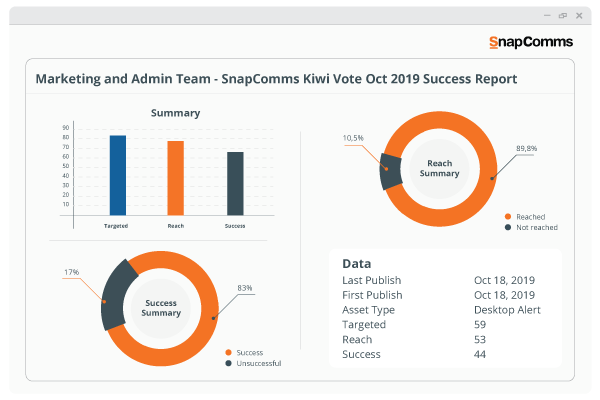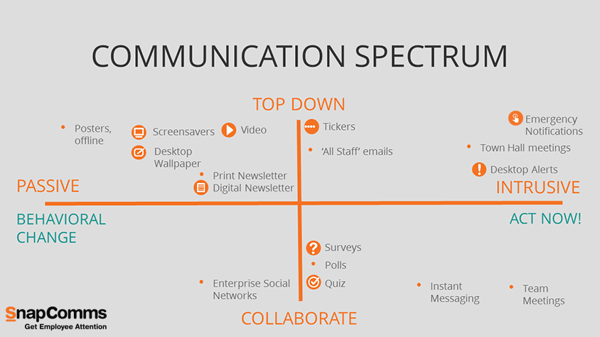
There are few things more dispiriting than seeing the internal communications campaign you developed disappear Titanic-like into the depths. Not only is it demoralizing, it’s a waste of hard work and effort – as well as a massive lost opportunity for the business.
And yet, many internal communications campaigns are doomed to end this way. In certain high-profile companies, the fallout from failed campaigns has been spectacular.
Unclear communications lost a leading telco their competitive edge. Mishandling of staff engagement at a web services company! (the ! is a clue…) hit their company performance. And the financial scandal at Enron was exacerbated by poor communication between management and staff.
But even in smaller organizations, research by Towers Watson has proved that 50% of all internal communications aren’t read. The result is an eye-watering $15,000 wasted per employee, per year.
I’ve worked with businesses on hundreds of internal communications campaigns. Some have fired – many have fizzled. But across all of them, there are five key reasons I see campaigns fail. This is what they are and how you can avoid them so that your campaign sails safely past the icebergs.
1. Lack of stakeholder buy-in
Securing the buy-in of senior stakeholders is an essential step in the planning of any new campaign. It’s an endorsement of approach and reassurance of backing – we succeed or fail together.
It’s perhaps understandable why so many internal communications managers neglect this – after all, it adds time and an extra layer of complexity. But those who fail to get buy-in find it significantly harder to secure any extra funding, resource or commitment later – a common requirement as circumstances change.
A lack of stakeholder buy-in also places the communications manager in a potentially awkward position if campaign results are less than stellar. They are likely to find themselves adrift without any support to back their corner.
To get stakeholders invested in the campaign, communications managers must speak their language. That means keeping high-level strategic goals in mind, aligning campaign objectives with these goals, and demonstrating a deep understanding of how the successful campaign will improve the business – not just achieve “better employee engagement”.
Focusing on only a narrow delivery of communication objectives, or insufficiently positioning the scope of the campaign, is as pointless as not seeking buy-in at all.

2. Not closing the achievement loop
Many internal communications campaigns fail simply because they can’t prove whether they succeeded. Either the objectives set for the campaign weren’t appropriate (or weren’t set at all) or there was no means of tracking performance against these objectives.
Failing at either of these means failing to close the achievement loop. Outcomes cannot accurately be presented back to senior management, time and cost expended cannot be justified, and the communications team cannot confidently prove their worth. Naturally, this will also make it much more difficult for any future campaigns to be approved.
The importance of setting SMART objectives should be known to every communications manager (but if not, here’s a useful summary of SMART objectives). Most importantly for us, they must be measurable.
This is good: Achieve 75% online staff enrolment in the company wellness program within 6 weeks.
This isn’t: Get all staff enrolled in the company wellness program.
Whatever communication platform you use, it needs to provide accurate reporting. Not just the number of impressions, but open, engagement and click rates, segmented by audience type. For example, the SnapComms platform features comprehensive channel reporting built-in. It’s exportable for easy analysis and ‘slicing and dicing’ of data.

3. Too many cooks in the kitchen
Opinions – we’ve all got them. Pick a subject and just about everyone will have a different view of it. Internal communications campaigns are no different. But too many opinions are counterproductive.
I’ve seen many campaigns where the proposed messaging and designs looked great, but after they were shown around the business, and senior stakeholders’ feedback was considered, the result was a real mess. Too many conflicting messages, too much detail, too little clarity of purpose. All of which only served to confuse staff.
It’s important to be more rigid, even ruthless, about whose opinion is valued or necessary. Keep the number as small as possible – just the communications team plus managers of any other affected teams (for example, Human Resources or Operations). Even the senior stakeholders engaged with at the outset needn’t necessarily be consulted at this point.
Inclusivity is great, but not at the extent of diluting your message and derailing the whole campaign.

4. Ineffective channel selection
Using the wrong communication channel for the job is the most common tactical mistake I’ve seen. Often it’s using a single channel like email to send messages to everyone, hoping they see it amidst their groaning inboxes (the ‘spray and pray’ approach). Or using a channel designed for one purpose for something entirely different (for example, using online forums to capture survey insights).
Employee message conditioning has a big influence here. This is where employees become accustomed to receiving a specific type of message in a specific way and are conditioned to act accordingly. For example, IT outage notifications delivered using a red alert.
But if that same channel and theme is used for other forms of communications, the association between red alerts and IT outages is destroyed. Relevance is lost and the messages are ignored.
This is why the use of single channels like email has become so ineffective, and why a range of different channels are needed for different communication goals – from high-visibility and intrusive, to passive and slow-burn formats.
Consider the communications spectrum below. The nature of your campaign, from top-down to collaborative, and from passive to intrusive, will help define the most appropriate communication tools.

For example, desktop alerts and tickers are vibrant and bold – ideal for launches or company announcements that staff need to notice. Screensavers and Lock Screen are highly-visual and memorable, well suited to reinforcing campaigns. Surveys and quizzes are interactive tools that provide immediate employee feedback.
Using a broad range of channels has become especially important with the influence of consumer communication preferences on the corporate world, particularly among younger workers.
5. Being inflexible
Remember that iceberg from earlier? Being stuck on a collision course and unable to change direction is a recipe for disaster. One I’ve seen many times in the world of internal communications.
It begins with a well-intentioned communicator and the plan they’re rigidly following. They’re sending pre-defined messages to set audiences at specific times. But these messages, audiences, and timings were established some time ago, before the campaign kicked off. And a lot can have changed since then.
Being stuck on a pre-defined course like this means not being able to adapt to changing situations or influences – technical issues which affect delivery, team restructuring, change in business strategy, or even just poor performance of initial messages.
Make sure to build flexibility into your communications plan. That way you have contingencies if circumstances throw you a curveball or the results to date force you to reappraise your plans.
You may need to rework or entirely replace a sequence of planned messages; run a series of messages earlier than expected; use a different communication channel entirely; or create a series of new messages tailored for a specific staff group.
Having the flexibility to adapt and refine ‘on the fly’ offers a significantly higher chance of campaign success, as well as having results you can confidently present back to stakeholders.
Internal communication is an essential catalyst for business improvement. By informing and inspiring your organization, it can marshal a mighty force to achieve your business goals – but only if done well. Follow these tips, avoid the icebergs, and watch your next campaign shine.



